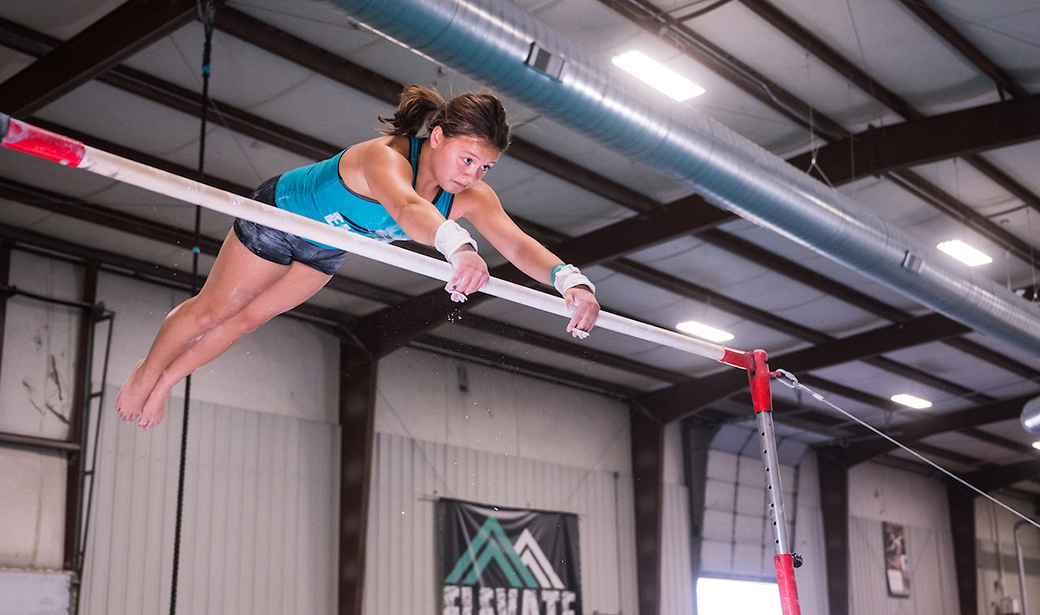Like many gymnasts, Marvi Turner fell in love with the sport at a young age. The first time she got on the uneven bars, she was hooked. Marvi started doing competitive gymnastics at three years old, and though she’s now a teenager, she still feels the rush that comes from doing her favorite turns, changes and dismounts.
“I love the uneven bars,” Marvi said. “I just love how it gives me a ton of adrenaline. It makes me feel like I’m flying.”
She’s made some of her best friends in the gym, where she spends as much as 18 hours per week. From the energy and fire of competition to the social scene in and around the gym, the sport is central to Marvi’s life and identity.
Those factors made it so much harder for her to take a break when her left wrist started to hurt in 2020. Marvi listened to her doctor, who told her to rest it for 6-8 weeks. But a month after she had finished resting, the pain returned, severe enough it kept her not just from doing vaults and handstands, but from turning her arm palm up to pick up a plate without pain.
“It was hard not being able to do the things I used to do so easily,” Marvi said. “My day-to-day life changed in an instant.”
Marvi and her family went back to the doctor, who suggested an MRI scan to look more closely at the problem, The Turners were referred to Julia Nuelle, MD, an orthopaedic surgeon who specializes in hand surgeries at the Missouri Orthopaedic Institute.
Nuelle diagnosed Marvi with a condition called gymnast wrist, an overuse injury of her radius, the arm bone closest to the thumb. As many as 40 percent of young gymnasts develop the condition, though not all progress to the point of needing surgery.
“Marvi did a wonderful job, if you want to call it that, of hiding the pain,” her dad, Chris Turner, said. “She never complained, and if she couldn’t pick up something with her bad hand, she picked it up with her good hand. She’s smart and talented, but also a little stubborn. We knew she was in pain, but it took us a little bit to figure out the cause.”
If gymnast wrist is recognized early enough, rest is enough to reduce inflammation and prevent the condition from worsening. Marvi had developed a severe form of gymnast wrist: The force and strain put on her wrist stopped her radius from growing before it normally would have, while her ulna kept growing.
“Marvi has always been energetic in every visit, and I always find it exciting to visit with her,” Dr. Nuelle said. “But she was really being hampered by wrist pain, and inability to move her hand from palm down to palm up. Marvi has an exceptional pain tolerance to be able to get to that level.”
Dr. Nuelle went over Marvi’s options with her family. They chose surgery so that Marvi would be pain-free even after her gymnastics career ended.
“The only way to make the ulna shorter is to take out a portion of it,” Dr. Nuelle said. “That’s a standard procedure for when the ulna is relatively longer than the radius, to go in and take out a wafer of bone to shorten it. That way the wrist is level and can move without pain.”
Dr. Nuelle performed the surgery in April of 2022. Two weeks after the surgery Marvi was fitted for a cast, and six weeks later the cast came off. The result made her cry.
“As soon as we took the cast off, I could fully turn it for the first time in two, three years, and it was so weird, I started crying, actually,” Marvi said. “I was just so happy.”
Not only was her pain gone, Marvi’s dedication to rehab also meant she lost very little range of motion in her wrist. Dr. Nuelle still remembers telling her young patient she could go back to practicing gymnastics with no restrictions.
“That was one of the best days,” Dr. Nuelle said. “Any time I have a patient that I can clear for full activity, and they're so thrilled to get back to something they love, is what makes my job so rewarding.”
Although Marvi’s story is a success, the Turners and Dr. Nuelle have the same message for families: If your child tells you they are in pain often, particularly if they specialize in one sport, listen. Go see a doctor early for the best chance of avoiding surgery.




